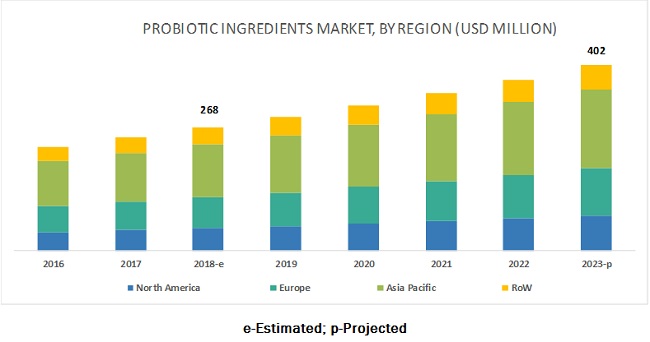The probiotic ingredients market is projected to grow from USD 268 million in 2018 to USD 402 million by 2023, at a compound annual growth rate (CAGR) of 8.5% during the forecast period. The increasing demand for dietary supplements in the pharmaceuticals, cosmetics, and personal care industries is projected to drive the market for probiotics, which in turn, is projected to drive the market growth for probiotic ingredients.

Download PDF Brochure:
https://www.marketsandmarkets.com/pdfdownloadNew.asp?id=238635114
The bacteria segment, by source, accounts for the largest market size during the forecast period
The bacterial segment is projected to hold the larger market share as it offers various health benefits. The most commonly used strains in the manufacture of probiotic products are gram-positive bacteria, which belongs to the genus Bacillus and yeast strains that belong to the genus Saccharomyces. For instance, Lactobacillus acidophilus when consumed orally is able to prevent infections in the vagina and also aids in nutrient absorption, while Bifidobacterium infantis helps the host combat bloating, diarrhea, constipation, and ulcerative colitis.
The liquid segment in the probiotic ingredients market is projected to record the fastest growth during the forecast period
Probiotic microorganisms are usually supplied in the form of culture concentrates, either in the dried or deep freeze form, for use in the food industry. The semi-liquid probiotic strains are usually offered in the form of gels and paste. Liquid probiotic strains are used in the production yogurt and buttermilk and are not available widely as compared to dry strains due to its shorter shelf life and the requirement of refrigeration during the transportation process.
Asia Pacific is estimated to dominate the probiotic ingredients market in terms of value in 2018
Probiotics are gaining popularity in the Asia Pacific market particularly in the animal nutrition segment due to the growing concerns about their health and productivity. The application of probiotic strains is projected to increase due to the consumer demand for application in functional foods and pharmaceutical end products. India offers a huge potential in this region due to the increasing number of pharmaceutical companies involving themselves in the licensing and development of probiotic drugs. China’s growth in terms of sales is attributed to the growing application of probiotics in the infant formula business.
Request for Customization on this Report:
https://www.marketsandmarkets.com/requestCustomizationNew.asp?id=238635114
This report includes a study on the marketing and development strategies, along with a study on the product portfolios of the leading companies. It includes the profiles of leading companies such as Kerry (Ireland), DowDuPont (US), Chr. Hansen (Denmark), Biogaia (Sweden), Probi (Sweden), Glac Biotech (Taiwan), Bifodan (Denmark), Lallemand (Canada), UAS Laboratories (US), and Biena (US).
Recent Developments:
- In March 2018, Kerry Group acquired, Ganeden Inc., a US-based developer, and manufacturer of probiotics, to complement its existing portfolio. Ganeden Inc. would help to strengthen Kerry’ nutrition and general wellness positioning in the US market.
- In September 2016, to strengthen its probiotic offering, Chr. Hansen acquired LGG, the world’s best documented probiotic strain from Valio Ltd. Valio OY is a Swedish company that provides for a range of ingredients for the food & beverage industry, besides consumer products.
- In January 2018, Biogaia introduced Protectis Probiotics—chewable tablets containing Lactobacillus reuteri protectis and vitamin D. This helped the company to strengthen its offerings within the probiotic strains segment.